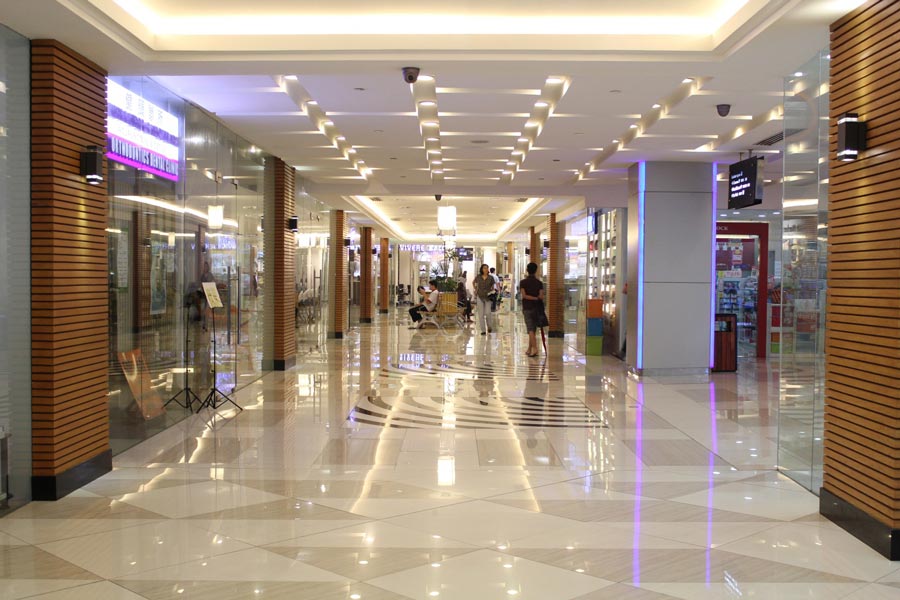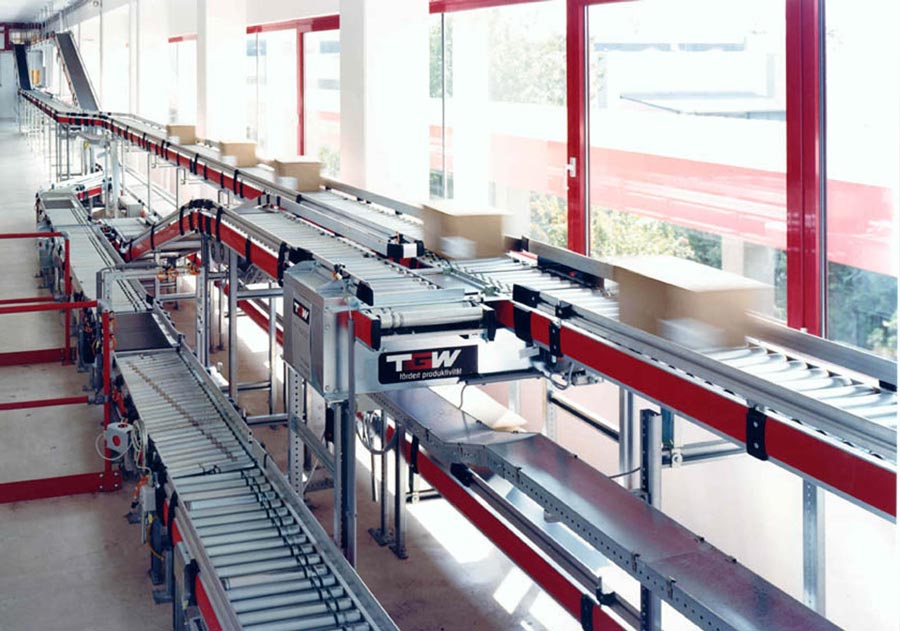The Paris Retail Week Fair returns for its second edition
Three days devoted to augmented retail
The second edition of the Paris Retail Week Fair will be held from 12 to 14 September 2016 under the roof of the Parc des expositions at the Porte de Versailles in Paris. This year the event is putting the emphasis on the theme of augmented retail. The 50,000 m² exhibition area will be divided into three pavilions, in which 1,000 exhibitors will represent their companies (start-ups and agencies), and the organisers are expecting no less than 50,000 visitors.
The fair will be punctuated by 300 conferences with the aim of defining current key issues, new trends and establishing optimal strategies, as well as shaping tomorrow's strategies. Participants will benefit from a simultaneous translation system from English so that everyone can follow the highlights of the fair.
Many prestigious international players will be present to share their expertise: Philip Rosenzweig, Vice President of Real Estate, Store Design & Construction at Kate Spade New York, will give his first public speech in France as keynote speaker on Monday 12 September from 3 pm to 4 pm. Maëlle Gavet, Executive Vice President of Priceline Group (the third international e-commerce group, and world travel leader), will also give her first oral presentation in France on Tuesday 13 September from 4 pm to 5 pm.
The Paris Retail Awards
This year's edition will see an excellent innovation in the event's programme: The Paris Retail Awards, which will recompense the 10 most innovative companies. The award “Rookie of the Year” will also be attributed to the most promising start-up. The jury has already selected 27 finalists divided into eight categories: Logistics, Customer experience (360), CRM: from the lead to the customer, Brand experience: “Award for Agencies, Technology, Digitisation of point of sale, Social commerce, and Store solution and design.
The new challenges of digital commerce
Today, traditional commerce must come up with a communication system that is not just an area of exchange between the customer and the company. Mobile tools and social networks have completely changed habits, expectations and preferences regarding e-commerce. The shopping experience is now a process which continues during every waking moment. Customers demand new developments adapted to the (mega-)connected customer world. This includes practical and innovative indoor geolocalisation solutions, electronic payment, shopping and personalised services. Consequently, the management of the customer experience must be made more and more fluid and intuitive.
For companies, this presents, more than ever, major challenges regarding the question of what the future holds, such as data collection, as well as gaining and retaining client loyalty. New prospects of augmented commerce must be introduced into current and future strategies. The aim is indeed to create a true symbiosis between the brand and the customer.
In reuniting the professionals of the retail and e-commerce community, the Paris Retail Week Fair has gathered together a dream team of the best of the international commercial sector. This should provide a complete synopsis of new trends and a total immersion in the practices of the most innovative digital sales.
Rendezvous 12 September at the Parc des expositions, 1 place de la Porte de Versailles, 75015 Paris.
Other posts :
- Artificial intelligence at the centre of digital innovations
- Towards a new shopper marketing
- Predictive geomarketing for companies: adapting points of sale to win over and create customer loyalty
Back to school for graphics: Ask for the programme!
September 2016 is going to be very busy in the graphics universe and agendas should be up-dated quickly to accommodate a hectic schedule. No less than four important meetings will be held in Paris.
L’UNIIC opens the proceedings on 23 September with a large general congress centred on the entire graphic sector. This will be followed by the Digital printing forum on 27 and 28 September, and Interquest's multichannel communication, which will focus on digital book printing. Finally, l’UNFEA will close this month of interprofessional exchanges on 29 September under the banner of “l’excellence dans l’étiquette” (Label excellence).
Viscom - 6 to 9 September
The 28th edition of Viscom kicks off the month of September on the 6th at the Porte de Villepinte. The three day programme features the exhibition of award-winning posters at the Creative Awards by Saxoprint, which will be further enriched by the prescence of Vizshoot by Fotolia. For the second year, an Innovation Gallery will present the major projects exhibited at the fair, and the Icona d’Or 2016 will be awarded by the Synafel (Syndicat national de l’enseigne et de la signalétique). Also scheduled on the three day agenda are two conferences and coaching.
“Voix d’experts, voies d’avenir: vers une reconquête graphique” (Expert voices, future routes: towards a graphic recovery)
On 23 September, the UNIIC (Union nationale des industries de l’impression et de la communication) will organise a large congress at the Maison de l’Amérique Latine in Paris, on the theme of “Voix d’experts, voies d’avenir: vers une reconquête graphique” (Expert voices, future routes: towards a graphic recovery). This event is organised for the benefit of the entire sector and will be animated by the economist and essayist Nicolas Bouzou. He will analyse the printing sector in France seen from the viewpoint of, among others, the Bank of France. This symposium will be the occasion to address the means employed in, and to analyse concurrently, the Asian and North American markets. Nicolas Bouzou's goal is to find future solutions in conjunction with branch experts and players.
Interquest at Salons Hoche on 27 and 28 September
Held during the last week of the month (27 and 28 September), Interquest will organise two forums at Salons Hoche in the 8th arrondissement of Paris. The first one will be dedicated to digital printing and to multichannel communication. The second (28 September) will concentrate on digital book printing. Since their creation in 2010, the first forum outlines the synergy between printed and digital communication, while the second reviews the important trends of the book market, the rise of digital printing and the evolution of the manufacture and supply chain.
30th meeting of UNFEA in the park de la Villette
Finally, on 29 September, the UNFEA (Union nationale des fabricants d’étiquettes adhésives) is organising its 30th “Rencontres placées sous le signe de l’excellence” (Meetings of excellence) in the park de la Vilette in Paris.
This year a round table will be held on the economic situation of the adhesive label branch followed by discussions on digital transformations and a general meeting. At the end of the day, the Qualétiq certificates will be awarded.
During these meetings, the organisers will be proposing three thematic circuits in the marketing and commercial, technical and quality sectors, as well as in administrative human resources. To conclude, Gordon Crichton, director of the MAI (Institut du Management de l’Achat International), lecturer at the École Centrale de Paris and at INSEAD, will talk on the theme of “Capter l’innovation chez les clients” (Capturing innovation with clients”).
Other posts:
- Development of digital printing with product personalisation
- Graphic designer: creating effective and personalised communication with a palette of colours and ideas
Ten marketing and communication books you should read now
Marketing and communication are undergoing constant development in the digital universe. For those people who want to keep themselves up to date with the latest publications in these sectors, here are ten works published by the Dunod publishing company to pore over.
La boîte à outils des réseaux sociaux ("The social networks toolbox") by Cyril Bladier
With 57 tools and methods at your disposal, you will know the best ways to take advantage of social networks and optimise your company's communication. Each tool is described in two to four pages with numerous links available by QR code to further your learning on the subjects.
Le marketing de soi ("How to market yourself") by Stéphanie Moran and Nathalie Van Laethem
Know how to sell yourself. That is the ambition of this work that describes 64 indispensible tools and methods to effectively promote yourself. It also contains textbook cases explained step by step. A good idea in the professional universe where freelancing is rapidly developing.
L'inbound marketing ("Inbound marketing") by Stéphanie Truphème
As the art of relating your journey or that of your company is primordial, this book perfectly details how to captivate your audience and convert them into customers.The author lists all the interactive possibilities between companies and consumers proposed by digital.
Tous digitalisés : Et si votre futur avait commencé sans vous ? ("Total digital: and if your future has started without you?") by Manuel Diaz
Digital is absolutely everywhere, we hear it repeated incessantly, even if French companies have difficulty in coming to grips with this. So that you won't miss out on the digital revolution and its implications, Manuel Diaz conveys its fundamental challenges and invites the reader to reflect upon one's responsibility regarding this economic necessity.
L'art de la guerre digitale ("The art of the digital war") by Caroline Faillet
If you don't know how to face up to the digital era, the author will provide you with the essentials to construct an adapted and well-planned strategy. In the same way as in Sun Tzu's famous "The art of war", you will learn how to devise your own digital arsenal.
Luxe et Digital : Stratégies pour une digitalisation singulière du luxe ("Luxury and Digital : Strategies for a singular luxury digitalisation") by Eric Briones
Digitalisation concerns all sectors, and the author has chosen to write about its application in the luxury domain. The first part is a broad overview to eliminate any complexes about digital. Then in the second part, Eric Briones avails himself of 14 experts who put forth how digital works in each sector.
Marketing de l'art et de la culture ('Marketing art and culture") by Dominique Bourgeon-Renault, Stéphane Debenedetti, Anne Gombault and Christine Petr
Art and culture also have a role to play in digital marketing, albeit one that always seems under-employed. To enlighten the sector's decision-makers, this work by several authors defines the particularities and challenges of digital marketing in art and culture.
Marketing et création publicitaire ("Marketing and creative advertising") by Virginie Barnier (de), Henri Joannis
A classique, this work comprehensively explains the most advanced corporate marketing and advertising strategies utilised in the creation of spots or advertisements. All the examples are updated and enhanced by the latest techniques.
Communicator (7th Edition) ("Communicator") by Assaël Adary, Thierry Libaert, Céline Mas, Marie-Hélène Westphalen
Digital marketing's Bible. To be owned and re-read. This new reworked and illustrated edition presents the authors and indispensable tools. Students and professionals alike can draw on this mine of information to incorporate marketing in their activities.
Other posts:
- Six corporate communication trends in 2016
- Web communication in companies: the challenges of successful programmatic advertising
- Companies and marketing: proposing quality advertising contents to reconquer internet users
Why the French are receptive to interactive point of sale supports
French consumer behaviour and expectations concerning businesses
Even if the French have changed their consumer style, shops remain the number one places of sale. In the digital and internet era, everything is progressing very quickly. We live in a world of the immediate; of real time, now and shortly. Faced with this rapidly changing world, different marketing managements in different sectors are on the lookout for the most pertinent sales supports. Today, it is both obvious and necessary to use new technologies in the buying act. To fit in with today's consumers, supports must be made more spontaneous and more emotional.
Currently, 65% of the French prefer sales points to internet sales, and this trend is increasing every year. The average basket is 208% larger at sales points than on e-commerce sites. Finally, we can also observe that 93% of the French consume more at points of sale thanks to their improvement of the buyer's journey. Commercial and distribution players have understood that these new digital services give back the power to consumers. Their utilisation of this trend is an attempt to find the best interactive supports, and particularly those that are best adapted to the expectations of today's consumers.
What are the interactive supports at points of sale?
Interactive concepts are supports that accentuate information and that easily incorporate a large amount of data: Interactive terminals, connected sellers, touchscreen displays, virtual fitting rooms, interactive sales books, 3D images and 360∞ virtual visits.
Today, 81% of the French express an interest in interactive terminals, 79% in connected sellers, 74% in tactile displays and 67% in virtual fitting rooms. Furthermore, interactive supports simplify the buying act and 90% of consumers estimate that supports give them a better orientation at points of sale. These supports are even considered by 83% to save them time. Finally, 69% of these same consumers are of the opinion that interactive supports make a shop more attractive. It is true that these terminals add a recreational or even fun dimension in the eyes of grocery shoppers. However, the shopkeeper has only a few seconds, three at the most, to attract the consumer. The first approach is therefore decisive. If the French are receptive to all the supports at points of sale, it is also because 92% of them search online before making a purchase at a shop. They are already well accustomed to the digital world. Having engrained itself into French habits, the tactile is in full swing and is still easy to use.
Today, interactive displays and software have reinvented the purchase act
After having tried for years to oppose online sales, brands are learning to revalorise their products and their physical networks by using all the interactive supports at their disposal.
The real world and the digital world are undergoing a reconciliation phase for the benefit and the prosperity of customers everywhere!
Other posts:
- Towards a new shopper marketing
- Eye tracking or how customers’ subconscious can dictate a company’s marketing policy!
- Virtual reality, the new marketing eldorado
Zulma Publishing House: Cover communication
The Zulma publishing house is characterised by its colourful covers and graphics. The covers are instantly recognisable and are both singular and accessible. The person responsible for these works of art is a talented and ingenious graphic designer.
Covers as works of art
The geometric motifs, colours and inverted triangles are the key to the success of Zulma's covers. An inspiration which comes straight from the Penguin publishing house during the 1950's and the German publisher, Insel verlag.
The publisher chooses, in effect, to utilise very graphic and iconic motifs for their covers. Circles, triangles, straight lines and stars are combined to produce a symmetrical cover.
Colours are also well represented and very much present. They are sometimes bright, flashy or even pastel but more discrete. The colours are in total harmony with the chosen design. The combination of the graphics and the colours is always well thought out.
Not forgetting the inverted triangle on a white background, geometrically formed and centrally positioned; something that all the covers have in common. Located near the top of the cover, it bears the name of the author, the title of the book and the initial “Z” for the publisher's name. Each book has its own typography which corresponds to the book's identity and its contents.
The striking combination of all these elements can be compared to a work of abstract art.
The work of an English artist
David Pearson, the Englishman behind these covers is a graphic designer. Laura Leroy, the director of the publishing house crossed the channel herself to ascertain the graphic designer's savoir-faire. She had already admired the earlier work of the artist, especially for Penguin Publishers. Pearson accepted to propose drafts to Zulma's director, who gave her opinion and instructions for any changes. The two protagonists worked in concert to produce cover models as extravagant as they are special.
A singular graphic design
The graphic designer, David Pearson, and the director of the publishing house, Laura Leroy, wanted to establish a unique graphic design for Zulma. This blend of graphic forms, colours and typographic choices has given birth to a unique visual identity . The published books may be all different but are still recognisable as productions from the same publishing house. This is exactly what the publishing house wanted, a way of distinguishing the company from other publishers and imposing its own design. Zulma books are instantly recognisable in bookshops thanks to their unique design. The visual identity of a company is primordial for its marketing communication and influence. It contributes to its success and its personality. Zulma, with its distinguished and atypical graphic choices, has succeeded in forging a strong image.
The impressions Margy Consultants propose their publishing know-how to companies and individuals for their advertising supports. Books, sales brochures, magazines, flyers as well as numerous paper supports can be adapted to the needs of each profile. Communication by way of image which accords each company an optimal visibility.
Other posts:
- Graphic printing, or the quality challenge
- Renewed growth for traditional publishing in 2016
- Paper publishing is still attractive, despite digital’s success
Four reasons why a company should develop its image
A company's visual identity takes on an important marketing dimension. It represents the first contact between a company and its target audience. During its existence, a company or business will be prompted to develop its image in an attempt to modernise it or just out of necessity.
Modernising an image
Society evolves year by year just like its inhabitants. Design and graphic trends change and develop in the same way. A company's image must adapt and evolve in line with the society so as not to appear dated. The company must adapt itself to new trends and modernise its visual identity. For this purpose, no need to change the entire logo, and it is not necessary to alter the company's image. A change of colour, of typography or graphics is enough. It is easy to see the natural evolution that the logos of the major brands (Renault, Ford, Coca-Cola, McDonalds) have undergone.
Target change
Sometimes a company begins by targeting a specific group, men, women, teenagers, family fathers for example. The company concentrates itself on the specific audience, and then, over the years, decides to enlarge the target group by proposing new products. In this case it should modify its logo to adapt to all the targeted groups. This type of development necessitates a change of logo more often than for a simple modernisation. The company may want to add a feminine touch to attract a more feminine clientele, to rejuvenate its image or reach a younger target audience.
Making public a major change of management
A company can be required to make public an important administration modification such as a change of management, a fusion, new values to highlight. All this represents without doubt one of the most profound developments of visual identity . The company changes its logo and image entirely in announcing this significant development. Particularly during the fusion of two companies, it is important to find a logo that corresponds to each of the parties and their values.
Introducing new products
A new product introduction is an important event for a company. For the occasion, a company may contemplate a change of logo. This can engender an important marketing impact and the announcement can be a good occasion to promote the event. A new image can be more attractive and arouse curiosity amongst consumers. This is an intelligent way to attract new customers and to provoke new sales. The company chooses to modify its logo distinctly or to make slight graphic modifications to it. However, to be remarked upon and to incite significant interest, these modifications, must be at the very least, striking and intriguing.
A change of visual identity is an attempt to refresh an image, to attract new customers or to announce an important event. Consequently it should be well thought out in advance and perfectly executed. There really does not exist a rule for the number of logo changes. Companies can develop their graphic design if its activity or stature justifies it. Be careful, however, not to change the logo too often, as this could have negative repercussions (difficulty or confusion in following the company's evolution), contrary to those hoped for initially.
Other posts:
- Caring for the company image thanks to its visual identity
- Branding: the company’s marketing window
- The infography, the key corporate form of communication
Towards a new shopper marketing
Who are today's shoppers?
Shoppers are all individuals with their own desires, needs, impulsive feelings, habits, reasoning and contradictions. Today, it is obvious that shoppers have become very demanding. They do not just want everything, but the best of everything! Shoppers are not against purchases made in a shop, but they want to take advantage of good offers, discounts and everything that online business has to offer. It is important, however, to always bear in mind that the buyer is not always the consumer.
The intelligence of shopper marketing
Shopper marketing embraces all the marketing stimuli destined to influence or trigger a purchase. In this sense, it is imperative to understand the expectations and attitudes of today's shoppers, as well as being able to decipher their choices. Shopper marketing must clarify all the questions posed by consumers. That is why many companies and businesses have merged their marketing and sales departments. Together, they are able to progress faster and share all that can be learned about the new shoppers.
By being the ones that make the purchases, shoppers find themselves at the centre of everything. Companies must know how to attract them and to talk to them at the right moment. Of course, the multiplication of channels, especially digital, make the entire puzzle more complicated and delicate. The hardest task lies in the fusion of the supports and gradually wiping out the barrier that separates the real world from the virtual world, thus leaving just one.
The challenge of shopper marketing
The last few years have witnessed a power transfer. The power has been relinquished by industry in favour of distributors. Today we see that this power has been usurped by shoppers, which radically changes the situation. In effect, distributors and brands have never worked together towards a goal of satisfying their customers. For companies and businesses, this implies a profound change of attitude. It seems urgent for them to develop their modus operandi. Furthermore, digital technologies have immersed themselves in the world of shopper marketing, and can no longer be ignored. Brands today must move towards conversational commerce in the goal of attracting the largest possible number of shoppers.
Shopper insights
Michaël Bendavid, managing director at Strategic Research, explains that “Stimulating innovation must be funnelled through a more attentive listening to consumers, the problems that the latter encounter in the utilisation of products or services, and in the expectations that they express.” The objective lies in analysing customer habits during the buyers' journey, and even their characterology. In psychology we define insight as “the sudden discovery of the solution to a problem without going through a series of attempts or errors”. That is why insight must be coherent, relying on a fundamental truth and mobilising a need or a desire. Quality and trend studies are in agreement today on the analysis of motivations, expectations and the shopper experience regarding products. Insight will therefore allow companies to orient their commercialisation policies in a more realistic fashion.
Other posts:
- Eye tracking or how customers’ subconscious can dictate a company’s marketing policy!
- How to develop your business using client knowledge?
Giving new life to paper and cardboard packaging
The growth of the packaging industry
According to a recent study, the global paper and cardboard packaging market currently at 87 billion dollars, will rise to 100 billion from now until 2020.
It can also be noted that 7,5 millions tons of paper and cardboard are collected in France annually. This figure has increased from 40% to 72% in the course of the last two decades. The collection of paper and cardboard household waste products has expanded each year by around 10%. For the tertiary service sector, paper and cardboard represent 85% of the waste products generated.
Paper and cardboard are the most recycled materials, with a higher rate than that fixed by the European directives. The outlets are extremely numerous and include the sectors of agri-food, luxury, pharmaceutical and cosmetics.
Ecological luxury
At this point in time the global luxury market is worth 1 trillion euros, and showed an increase of 5% in 2014. The luxury sector contributes to the promotion of the French image, and as such takes on a particular aspect. In the luxury sector, packaging plays a key role since it has an impact on consumers' senses and emotions. To be able to respond to the increasingly challenging demands of consumers concerning the future of the environment, the luxury marketplace is gradually looking towards the concept of “durable luxury”. Today, many major brands (jewellery, perfumes, ready-to-wear, leather goods, shoes) choose the option of “sustainable development”.
Printing, decorating, cutting. The printing technologies are also adapting themselves to paper and cardboard. Thanks to the latter, personalised packaging is on the increase. Printed bags, gift boxes, cases, wrapping and advertising packaging, as well as gift packs, jewellery boxes etc - in today's world, anything is possible!
Cardboard, the future of food packaging
Cardboard is a light, malleable, recyclable and compostable material that is endowed with a large number of qualities that make it the ideal packaging material for the agri-food sector. The cardboard is often covered with a fine layer of paraffin wax, which permits it to withstand fat and grease. It can also be combined with polyethylene and aluminium to create hermetically sealed packages. Cardboard is utilised in the fabrication of a great deal of food packaging such as milk and fruit juice boxes, boxes of rice and sugar, food packaging trays, pizza packaging, as well as disposable plates and cutlery. With an annual growth of 6%, the cardboard that we know today is enjoying a veritable resurgence in the agri-food sector.
Paper in the future
Yesterday, paper was utilised more as a commodity, once read it was thrown away immediately. Today, paper is both a material and a resource. Laboratories work on its transparency, its resistance to water, its conductivity. This enables the possibility of new uses for tomorrow's paper. The global demand for paper packaging should reach nearly 273 million tons in 2022, compared with 195 million in 2014, which is an annual increase of around 4%. Recycled or transformed, paper and cardboard have many years of good use in front of them.
Welcome to the intelligent world of packaging.
Other posts:
- Visual and packaging communication supports: the paper industry world in constant search of innovations!
- KOLBUS will jump start luxury packaging at the DRUPA 2016 trade fair!
Mobile advertising monopolises digital advertising budgets
The forecast was received without surprise. In 2017, the volume of mobile advertising will overtake that of the PC, according to the ZenithOptimedia agency. A success, which has been achieved to the detriment of other media. For the first time, mobile will become the third global advertising investment platform.
Having become today's indispensable tool, the mobile has rapidly gained ground in the advertising universe the last few years. A fact that marketers have from this point forth completely incorporated. In 2017, advertisers will spend 87,6 billion euros to maintain a mobile presence, thereby accounting for 2% more than the budget destined for advertising on PC internet pages.
The public appreciates creative and natural mobile advertising
This increase in the budget for mobile advertising comes at the expense of other digital advertising, where a drop of 6% from now until 2018 is expected. Here, advertisers are slavishly following the reality of the figures. In a recent study conducted by Quantast, based on a panel of 3,700 English, German and French consumers, 64% of respondants stated that they were influenced by mobile publicity. A percentage that reached 80% in the 18 - 34 age group. The degree of this success for advertisers would be even more pronounced if their advertisements displayed more creativity!
Video and social networks, the favourite targets of mobile advertising
The object of all their attention, native advertising is the favourite of mobile users since it naturally incorporates brands' edited content in line with our reading habits. According to the Enders Analisys agency, the budget for native advertising will triple from now until 2020 when it will have grown to 13,6 billion euros.
The other big winners of mobile advertising are social networks, video and programmatic.
Advertisers regard the social networks as a godsend and have rapidly taken to this new and less conventional terrain. Investments for video advertising have seen a constant growth (+34%) and should reach 434 million this year in France. All the mobile advertising innovations take advantage of the impact of programmatic advertising.
Mobile advertising stifled by ad blockers
Having already become an indispensable tool, smartphones enable an even better targeting of consomers. They are a dream support for programmatic which when coupled with geo-localisation optimises click transformation. Programmatic is already employed by 50% of advertisers, and they will be 80% by the end of the year.
An analysis of mobile advertising growth shows that it has not stopped improving and adapting itself to our favourite connected toy. This has occurred at the cost of PC advertising where the budget curve has stabilised as with other media.
However, advertisers should not forget the old saying “too much of a good thing”. More and more mobile users, exasperated by an advertising all too intrusive, install ad blockers to avoid its propagation. From now on, 429 million smartphones will be equipped with this type of application. If this trend worries advertisers, it should at least remind them that it is a good idea not to put all their eggs in one basket. In France where the advertising market will rise to 9,9 billion euros in 2017, traditional vectors have withstood the onslaught. Télévision continues to win market shares and is currently ahead of internet, while paper advertising with a 28% share of the cake continues to write history.
Other posts:
- To captivate the Generation Y (or Millennials), businesses must adopt the most efficient advertising strategy
- Programmatic advertising is on its way to conquer the mobile
- Development of behavioural mobile retargeting
Six corporate communication trends in 2016
The advent of digital has shaken up corporate marketing strategies. Constant digital innovations linked with new consumer practices, have applied pressure on brands to continually readapt themselves so that they better respond to their customers' needs. Webmarketing.com has created an infography which presents six new trends in brand communication in 2016. This is based on a synthesis of the latest studies by Google, HiMedia and Millward Brown.
Big Data opens the way for a more targeted communication
Big Data represents an immense information potential for data collected on Internet. Once analysed, this data allows a more personalised marketing strategy. The latter presents a major challenge for companies, particularly in terms of advertising campaigns. Customers are very receptive to personalised advertising messages; 43% are inclined to make purchases more frequently, and 32% are induced to buy more products.
Communication on multiple social networks
Even if using Facebook for advertising campaigns today has become evident, there are also other social networks that are just as pertinent. Instagram's 400 million active users, Twitter's 307 million, and not forgetting Google +'s 300 million represent potential customers that companies must take into account in their communication strategy. All this of course is to be weighed against Facebook's 1,55 billion users. Consumers are especially influenced by the three following contents: promotional campaigns, friends' publications and advertising.
Communication by smartphone
The fact that a European possesses on average 1,3 mobiles in 2016 constitutes a major communication channel for companies. Their advertising is therefore directed increasingly more towards smartphones. What's more, the expansion of mobile usage modifies consumer behaviour in shops. So it follows that in a shop situation, 57% of users will contact a friend to have their opinion, 56% will compare prices online and 54% will send a photo of the product concerned to have a second opinion and receive comments.
Social communication by instant messaging
To develop customer relations, companies favour a presence on social networks. This allows them to increase their renown, to sell more and to create brand communities. In 2016, businesses and companies are going even further in the link that binds them with customers by opting for direct communication by instant messaging software services: Tencent QQ, WhatsApp, Facebook Messenger, etc.
Video communication
Very much appreciated by customers, video is increasingly solicited by companies in the context of their marketing strategy. Investments in this tool are in a constant growth spiral in Europe. Although behind Great Britain, France is very active in this sector, having spent 360 million euros in 2015. Programmatic, which uses automatic algorithms, represents nearly a quarter of the video advertising content market in 2016.
Native communication and ad blockers
The use of ad blockers, which hinder the appearance of internet advertising, is growing. Ad blockers are employed by 200 million users worldwide, of which 77 million live in Europe. Anti-advertising software is the cause of a global net loss of 37,2 billion euros for web sites in 2016. To combat this problem, companies must modify their communication planning. They must, therefore, develop native advertising, a less obtrusive form, that furnishes content to customers within their user journey.
Other articles :
- Eight good reasons to use video in your communication
- The Big Data trade fair devoted to predictive marketing











